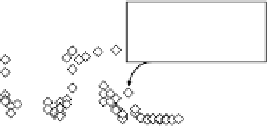Environmental Engineering Reference
In-Depth Information
250
200
150
Large industrial
discharge to sewer
ceases
100
50
0
Dec-01
Jan-02
Feb-02
Mar-02
Date
FIGURE 8.9
Inl uent 1,4-dioxane concentrations at Water Factory 21. (From Woodside, G.D. and Wehner,
M.P., 2002, Lessons learned from the occurrence of 1,4-dioxane at Water Factory 21 in Orange County, Cali-
fornia. Proceedings of the 2002 Water Reuse Annual Symposium. Alexandria, VA: WateReuse Association.
With permission. Courtesy of the WateReuse Association.)
in Figure 8.9 (Woodside and Wehner, 2002). According to USEPA's
Toxic Release Inventory
, from
1993 to 1996, the membrane manufacturer discharged 1,4-dioxane to the sewer at rates ranging from
48,000 to 87,000 lbs/year (USEPA, 2008a). This mass of 1,4-dioxane was apparently sufi cient to
overcome the dilution occurring over more than 5 miles of transit in sewers to Water Factory 21.
8.6.3 W
ASTEWATER
T
REATMENT
AND
1,4-D
IOXANE
R
EMOVAL
The passage of 1,4-dioxane through Water Factory 21 shows that the series of advanced wastewater
treatment steps were not coni gured for 1,4-dioxane removal. The treatment technologies included
GAC, air stripping for ammonium removal, and reverse osmosis, all of which are ineffective at
removing 1,4-dioxane. In addition, treatment at Water Factory 21 in 2002 included UV light with
hydrogen peroxide, a technology that is widely used for 1,4-dioxane removal. The UV-peroxide
treatment step uses a 70-MGD Trojan UV-Phox low-pressure, high-output lamp system. The Trojan
UV-Phox was added in 2001 to remove nitroso-dimethyl amine (NDMA), another potentially car-
cinogenic contaminant discovered in 2000 (Deshmukh, 2007). Hydrogen peroxide was added at
less than 5 mg/L, which was apparently insufi cient to remove 1,4-dioxane to below the action level.
UV light with hydrogen peroxide concentrations in the range of about 10-15 mg/L would have
achieved more signii cant removal of 1,4-dioxane; however, the Orange County Sanitation District's
successful effort to locate and eliminate the discharge made increasing the hydrogen peroxide feed
unnecessary (Woodside and Wehner, 2002).
8.6.4 C
OMMUNICATING
WITH
W
ATER
U
TILITIES
AND
THE
P
UBLIC
ABOUT
1,4-D
IOXANE
IN
D
RINKING
W
ATER
W
ELLS
Removing the source of 1,4-dioxane in Water Factory 21 did not put the local water utilities and the
public at ease, as the nine wells remained contaminated with 1,4-dioxane. CDPH ofi cials urged the
public not to worry and noted that the local water agencies acted out of an abundance of caution by
testing for 1,4-dioxane and closing wells despite relatively low levels of contamination. CDPH staff
reminded city ofi cials that the three parts per billion level is the amount expected to cause one extra
case of cancer per million people who drink 2 L of contaminated water every day for 70 years
(Mehta, 2002a). CDPH evaluated the relatively low concentrations of 1,4-dioxane detected in the
nine supply wells and assured water utility ofi cials that the concentration of 1,4-dioxane did not
represent a signii cant risk to health. On the basis of CPDH's recommendation, the production wells
were returned to service (Woodside and Wehner, 2002).




Search WWH ::

Custom Search